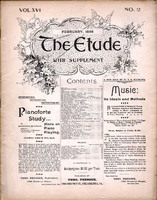[Our subscribers are invited to send in questions for this department. Please write them on one side of the paper only, and not with other things on the same sheet. In Every Case the Writer’s Full Address must be Given, or the questions will receive no attention. In no case will the writer’s name be printed to the questions in The Etude. Questions that have no general interest will not receive attention.]
L. A. P.—It is not an easy thing to explain, in a few words, such a subject as phrasing. Perhaps it will help you if you are referred to the matter of punctuation as used in ordinary writing. You know how unintelligible a sentence or, better still, a paragraph will become if you take away all commas, semicolons, and periods. Now, a composition may be considered as a complete work, broken up like a chapter into paragraphs, sentences, and phrases; and the curved lines of various lengths indicate the extent of the different divisions (sometimes called phrases) of a composition. It is important to note this, since otherwise the mind of the hearer has no resting point, as it were. If you have done or should do some study in analysis, you will find the subject become very clear. Mendelssohn’s “Songs Without Words” will furnish good study in phrasing.
C. N. Y.—Intervals are named from the number of letters they include therefore the interval between C and a is a sixth. If written C-sharp-A, or C-A flat, it is called minor, because they are separated by eight half-tones (the half-tone is always used as a “measuring rod” in determining the kind of an interval); if written C-Ay it is a major sixth, as they are separated by nine half-tones; if written C-A sharp, it is an augmented sixth—they are separated by ten half-tones. C-B flat in our tempered scale are represented by the same sounds or the same keys on the piano as C-A sharp, but C-B flat includes seven letters, and consequently is called a seventh.
The relationship of scales depends on the tetrachords they possess in common; thus the tetrachord C, D, E,F, belongs to C and F, therefore they are related; the tetrachord G, a, B,C, belongs to G and C, therefore they are related. Consequently every scale has two major relatives. Every key has a relative minor, therefore the group of related keys contains three major and three minor scales.
The relatives of a minor key are those keys that are related to its relative major. Therefore the relatives of a minor must be C major, F major, G major, D minor, and E minor.
The relationship of scales is exhaustively treated in a work by Dr. h. a. Clarke, now in press, in which this relationship is made the basis of a simple system of learning harmony.
H. E. R.—There is absolutely no rule that governs publishers in accepting compositions for publication. All depends upon the reputation of the composer, the merit of the composition, its suitability for the catalogue of the publisher, and also the supply of the style of the composition submitted may be out of proportion to the demand. We have lately rejected all two-steps; we have published about as much as we can well handle in that line. The waltz movement is also losing its popularity. The above are only a few of the points that have to be taken into consideration in making a decision as to accepting a composition. It may be of interest to know that we do not accept one piece out of ten that are sent to us.
M. A.—We suppose that you mean reed-organs in your question as to the meaning of the terms “8 ft.” and “4 ft.” in connection with stop names.
The terms are borrowed from the pipe organ. The low C, second leger line below the staff, bass clef, which is also the first key on the pipe organ, is produced by a pipe eight feet long. This is the normal octave, so to speak, and corresponds to the pitch as given on a piano. Instruments which produce tones in this same register are called of 8 ft. tone. If you draw out a 4 ft. stop you will note that the pitch, using the same key, is an octave higher than that of the 8 ft. stop. If both are played together the effect is as if two voices sang a melody an octave apart. If you use a 4 foot stop in the treble, you must also draw out an 8 ft., otherwise your bass and treble will |be two octaves apart. Some reed-organs are provided with a 4 ft. bass stop, which can be used with a 4 ft. treble stop to produce a light, soft effect, especially if the playing be done an octave lower than the printed notes call for.
E. P. V.—A rule often given to find the key of a composition is to note on what degree the final chord of the piece is based. In the great majority of cases the bass is the tonic, and you will name the piece accordingly. For example, say the bass ends on A. If the signature is three sharps, the key is A major; if the same as C—that is, without sharps or flats—the key is A minor, since A is the sixth degree of C major and the relative minor of C. This may be formulated in the following manner: If the last bass note is the sixth of some scale, the key is the minor of the same degree as this bass note. In some late compositions, such as Sousa’s marches, the piece ends with the trio. In this case, the key of the piece is determined by the first or principal movement, which is always the leading factor in fixing a key; similarly, when a movement has several subjects, go by the first.



